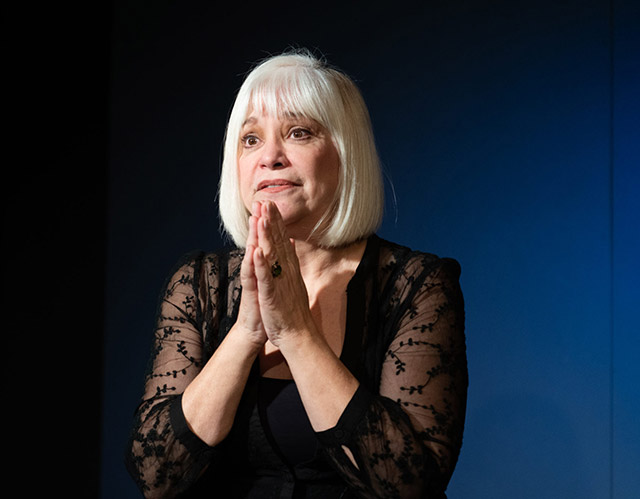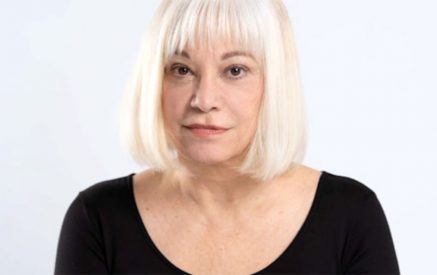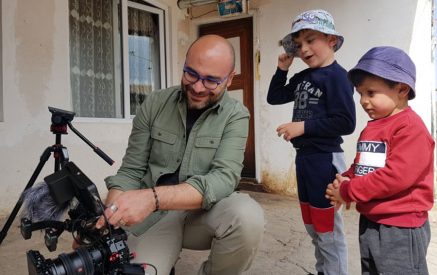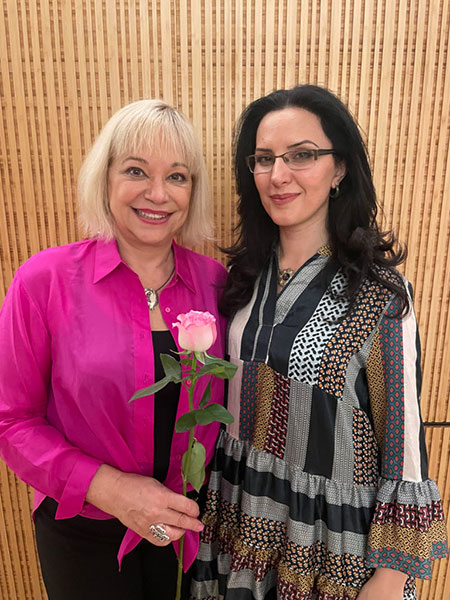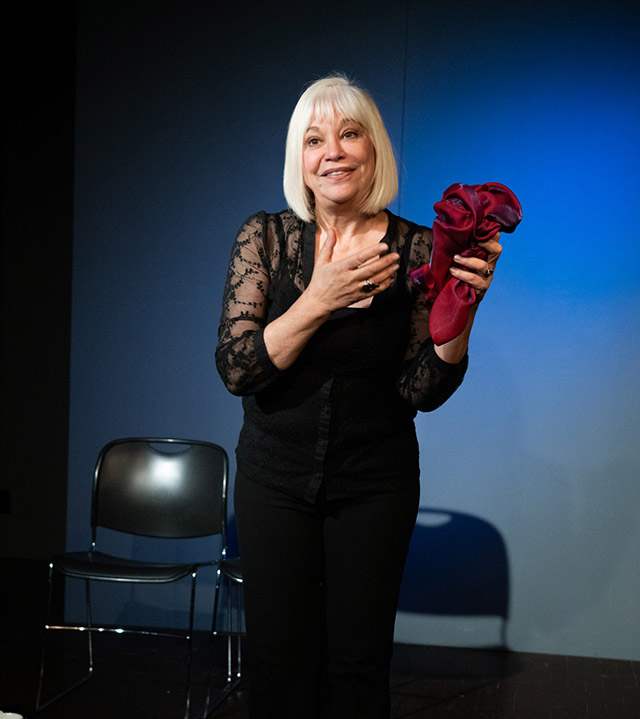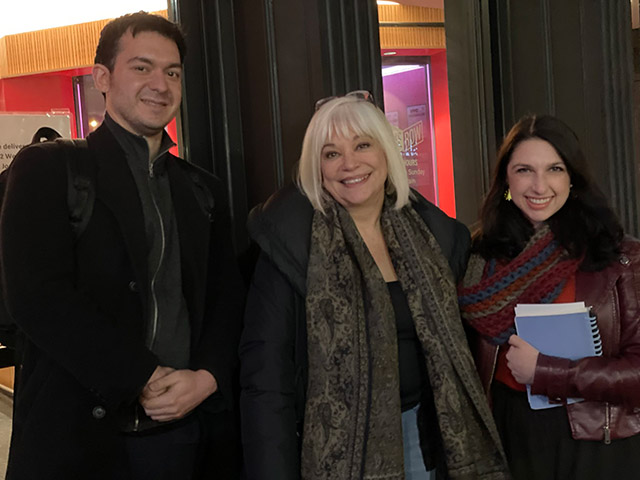The afternoon of Sunday, November 21, 2021 saw a black box theatre in Theatre Row on 42nd Street filled with a joyful, supportive and engaged crowd to watch Nora Armani return to the stage in her one-woman show “Back on the Couch with Nora Armani.” The piece was performed as part of the UnitedSolo Theatre Festival, which supports performing artists in bringing solo performances to the stage.
Armani is an award-winning actor, voice artist and filmmaker with numerous film and stage credits. Her impressive resume lists not only her acting work, but also a number of special skills, including seven languages, basketball, volleyball, swimming, belly dancing, ballroom dancing and singing. Her multifaceted identity is the basis for her performance. She is also the producer of the Socially Relevant Film Festival in New York City. Armani is also passionate about giving back to her Armenian community.
“The last couple of years, I came to the conclusion that every Armenian should go and live in Armenia,” she told the Weekly. “Of course, there are reasons people need to be somewhere else, for a particular purpose. But when that purpose is fulfilled, then you need to go back and pay your dues.” Armani, for her part, has led master classes for actors in Yerevan and Shushi. Her desire is that Armenians will learn to have faith in “return business” and long-term planning, rather than short-term gains from the occasional project that’s produced in Armenia. She would like Armenians to make better connections in international entertainment to boost the economy more permanently, but understands that education about the industry worldwide may be necessary for this to occur.
Read also
This event was not Armani’s first performance of this piece. The show has a 20-year history. She conceptualized it in 2001 while living in London after being offered to put on a one-woman show by an Indian producer with access to a theatre. She performed this act for the first time, in a hall in the house in which she lived, before an invited audience that included Dutch filmmaker George Sluizer (of “Dark Blood” fame). Unfortunately, the Indian producer passed away, and Armani was subsequently offered to perform in Paris, where she translated the show into French. Director François Kergoulay attended the performance and immediately wanted to work with her. “For people who don’t know the story, it’s a discovery. For people who do, it’s an identification,” he told her. After touring in Paris and the US, she set the show aside for a few years to work on other projects, eventually returning to it this year for the UnitedSolo Festival. People from many different ethnic backgrounds, including Turkish, have seen her show. Armani feels that art “instructs, educates, enlightens and inspires” and noted that she received positive feedback from these individuals who were able to sympathize with her family’s history and express a desire for recognition and reparations.
In this performance, Armani made some revisions to her original piece. However, she made one point very clear. “I don’t revise the identity,” stated Armani. “That’s the part that is constant. I’m not going to rewrite my grandmother’s and grandfather’s story.” Armani’s revisions were primarily in the beginning of the play when she referenced casting, texting, smartphones and other technology that has complicated the industry in ways that did not exist when she first wrote the piece.
When walking into the theatre, the black box stage appeared quite simple: one oriental rug on the floor, a black box, two black chairs and a red scarf. There were no special effects with sets, lighting or costumes, and minimal props were introduced throughout the show. From the start, it was clear that Armani’s presence and storytelling would be the primary focus. She noted in an interview that this setup was a recommendation from her director, who stated, “I want people to listen to you, to look at you, not look at your props and be distracted by them.”
As the lights dimmed, Armani entered the stage and emanated pure joy and gratitude while speaking to the audience, who responded in kind with strong applause. “I really meant it at the beginning when I said, ‘It’s really wonderful to see you all here in person instead of behind computer screens!’” Armani reflected. She began to take us on a journey through struggles of both personal and artistic identity and growth. Armani first explained the challenges of developing an identity as an artist and how she has overcome them to achieve success. As an Armenian actress who also has some “ethnic” features but does not fit strongly into the categories often identified in casting calls, one statement made by Armani deeply resonated with me: that she is either “too ethnic or not ethnic enough” in the acting industry. While this statement was made regarding the performing arts, I believe it is a sentiment that can be felt by many Armenians in the Diaspora as we delicately balance assimilation and cultural retention. Armani’s ability to take her specific experiences in various cultures and settings and make them more widely accessible for her audience was one of the many strengths of her writing and performance.
After humorously lamenting about the trials and tribulations of finding her place as an actress in the current world of diversity and inclusion, Armani invited the audience to “leap” into her invisible world. However, this leap is interrupted by the presence of an ex-partner in the audience. For much of the performance, Armani breaks the fourth wall and speaks directly to the audience, engaging in a storytelling approach rather than acting. When acting, she embodies some of the characters and speaks to imagined versions of the people in her life. This effective method of storytelling deepens the audience’s connection to Armani’s emotions and relations with those who have influenced her. The audience is introduced to her family history, contained in the bulk of the show, when she tells her former lover that she is jealous of his uninterrupted genealogy.
The remainder of the play follows Armani’s family history and her relationship to her cultural background. She emphasizes the importance of telling her grandparents’ stories combined with personal “coming of age” stories, including her first explorations of relationships with men. The audience is provided with stream-of-consciousness vignettes of her childhood and teen years. Armani weaves depth with humor in order to provide balance in her art. She shares familiar narratives of survivor stories, displacement, immigration and her grandparents. In a particularly striking moment, she physically embodies her grandmother’s trauma through movement reflecting her near-death experience and subsequent survival on a march through the desert. Armani makes clear that there were times she wanted to forget or erase her history to live a “normal” life. There are moments when the show is as much a history lesson about the Armenian community in Egypt as it is about Armani’s experiences. She reflected on important feedback she received from the first director she worked on the show with in London. Originally, Armani included much more history. Her friend once advised: “If I want to know the history of Egypt, I can go pick up a book about the history of Egypt; I want to hear your story.” Armani notes, “That’s what put me on the right track.”
Audiences are then transported on her journey to the US from Egypt, leaving behind her childhood home to pursue the American dream. She tells stories spanning from New York to Hollywood summed up in the line, “America, America! What have you given me in exchange for my cultural luggage? Balls!” In this new chapter of her life, Armani explores how she gained strength and worked through identity confusion, initially trying to hide and assimilate to become more American, then releasing some of her dreams to live more authentically. As she explains more in depth, this meant releasing relationships and images of who she thought she should be, releasing inauthenticity and allowing herself to be fully present in the roots that gave her spirit and a home.
Armani’s choice of music in the show was striking and intentional. Though not a musical, she carefully chose which songs to sing and when to incorporate recorded music to enhance emotional connection. For example, when sharing the story about her grandfather going to Egypt from Erzerum, she specifically chose music played on the duduk to be “evocative, wistful and nostalgic.”
As an Armenian-American actress, I often felt that Armani was telling my story of trying to find my own place in the industry. In our conversation the day after the show, she said, “Our job as actors is to audition. When we get the role, it’s like the cherry on top. It’s the reward.” She excitedly shared a story of being picked to audition for a film being directed by Jean-Luc Godard, a famous French-Swiss film director. Her resume and headshot were hand-selected from many, and she was invited to an audition (a rare occurrence in the industry). Actors are not usually paid for auditioning, but this particular director provided Armani with a stipend for taking the time and energy to attend. This experience stuck with Armani, and she did not take it for granted. She had been chosen due to her look and her fluency in many languages. The most important takeaway from Armani’s play and personal stories is this: stay true to the many facets of your identity, and you will find authentic success.




















































